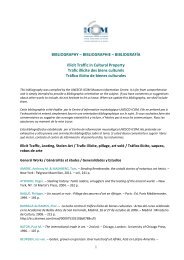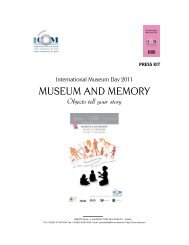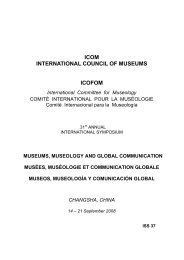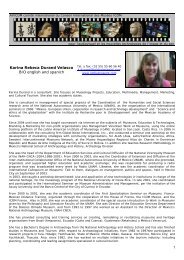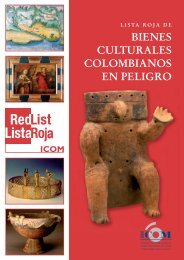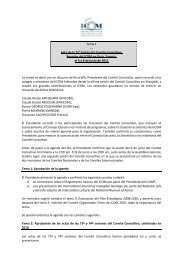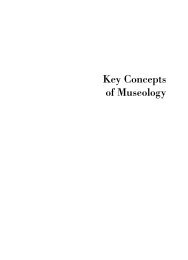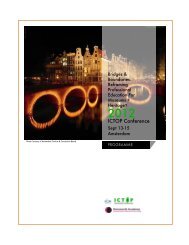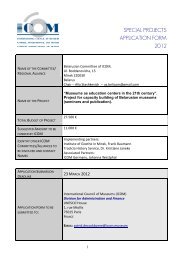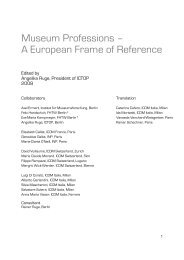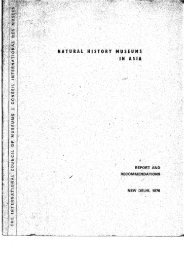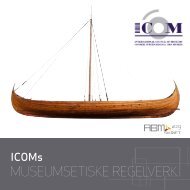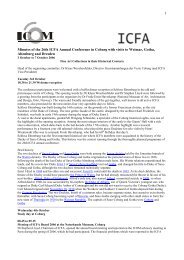ISS 25 (1995).pdf - The International Council of Museums
ISS 25 (1995).pdf - The International Council of Museums
ISS 25 (1995).pdf - The International Council of Museums
Create successful ePaper yourself
Turn your PDF publications into a flip-book with our unique Google optimized e-Paper software.
II.<br />
Looking at the Nordic museums, i.e. museums in Scandinavia and Finland. as<br />
a whole, the pattern is both similar and different. <strong>The</strong> lerm 'Nordic' covers<br />
the Scandinavian countries Denmark. Iceland. Norway and Sweden together<br />
with Finland. today with roughly <strong>25</strong> millions inhabitants. <strong>The</strong> Scandinavians<br />
are linguistically closely related, Finland has through its union with Sweden<br />
from the Middle Ages until 1809 a history and culture closely related to<br />
Scandinavia. Its Fenno-ugrian language is furthermore shared with the<br />
Sami population in northernmost Scandinavia. From the common historical<br />
destiny <strong>of</strong> the countries has grown a loyalty which has been most explicitly<br />
expressed and reached peaks <strong>of</strong> enthusiasm in periods <strong>of</strong> aggression from<br />
'without'. So at tlle end <strong>of</strong> the 19t1l centuJY when the solidarity with<br />
Denmark in its conflict with Prussia inspired the scandinavistic movement<br />
among unlversity students, so in the years <strong>of</strong> me Second World War. After<br />
1945 formal organisations have been established to promote cooperation in<br />
various fields <strong>of</strong> ("Ommon interest. One <strong>of</strong> mose organisations is tbe<br />
Scandinavian <strong>Museums</strong> Association, which however was founded as early as<br />
1915.<br />
Obviously me early period <strong>of</strong> Nordic museum history is dOminated by<br />
museums from above.<br />
Denmark being part <strong>of</strong> the continent has through the ages served as<br />
mediator ()f European cultural influences. Thus me first museum ideas no<br />
doubt were those introduced by the Danlsh physician Ole Worm living in the<br />
late 16th and early 17th century. He had become acquainted with collections<br />
and collectors during his years <strong>of</strong> study, which in mose days were spent<br />
mostly in Italy and Germany. His main subject was medicine, but his<br />
interests were wide and he was deeply influenced by the antiquarian spirit<br />
and archaeological activi ties <strong>of</strong> the age. On returning to Copenhagen in 1611<br />
he visited the famous collector Moritz me Elector in Kassel as well as<br />
Paludanus, collector <strong>of</strong> ethnography in Enkbuizen, the Netherlands. He<br />
became pr<strong>of</strong>essor <strong>of</strong> Medicine in Copenhagen and began collecting in the<br />
1620's witll a view to <strong>of</strong>fer his students objects for study. He entertained a<br />
wide correspondence with the learned Europe concerning items for his<br />
collection and started to work on a catalogue which was however printed<br />
only in 1655, me year after his deam. <strong>The</strong> catalogue, Museum Wonnianum,<br />
became influential as one <strong>of</strong> the first manuals for ordering a collection <strong>of</strong><br />
natural history specimens, making me important distinction between<br />
'naturalia' and 'artificalia'. You have certainly seen me engraving from me<br />
catalogue which is <strong>of</strong>ten reproduced in books on museum history.<br />
But on the whole collecting was a royal and princely pursuit. So in Denmark<br />
and in Sweden. After humble beginnings in the reign <strong>of</strong> his predecessors<br />
the Danlsh King Frederick III in the 1640's began to arrange a collection in<br />
me turnlng cabinet <strong>of</strong> me Royal castle in Copenhagen in the fashion <strong>of</strong> the<br />
age. He was much inspired by travelling in France and the Netherlands<br />
where he met with collectors and studied many <strong>of</strong> the famous collections.<br />
<strong>The</strong> influence <strong>of</strong> his cousin Frederick residing at me Gottorp castle across<br />
me border to Holstein was <strong>of</strong> special importance. He had completed a<br />
KunstkanlIDer in 1648 headed by his Court Mathematician and Astronomer<br />
Adam Olearius. In 1651 Olearius managed to acquire Paludanus' collection<br />
from Enkhuizen and thus to enhance the fame <strong>of</strong> the Gottorp collection.<br />
Frederick III in 1654 acquired Ole Worm's collection which was at that time<br />
internationally well-known because <strong>of</strong> me catalogue. In 1665 it was<br />
transferred from me castle to a building specifically designed for me<br />
purpose. Ole Worm's close to 1800 letters covering the period 1607-1654 have<br />
been published and mirrors the wide net <strong>of</strong> contacts with scholars allover<br />
180



